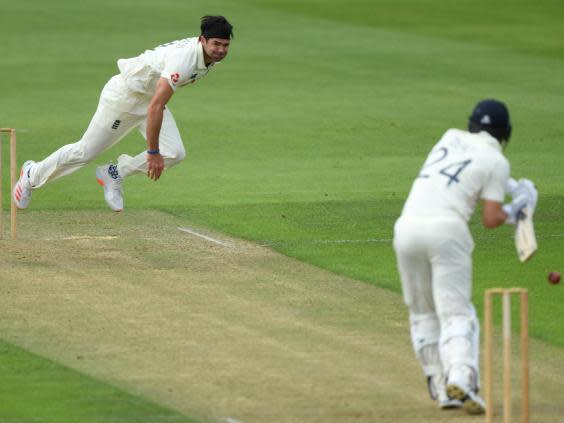Freak of nature James Anderson becomes freak of circumstance in cricket’s coronavirus era

In a sport that revels in pedantry, the return of Test cricket on Wednesday presents a conundrum for the defenders of the record books.
New regulations such as prohibiting the use of saliva on the ball, additional DRS reviews and Covid-19 replacements will be in play for the first time when England play West Indies at the Ageas Bowl, starting on Wednesday.
All these changes are necessary for the revival and survival of the game. But they are changes that will alter how it is played. For all the sports returning in a coronavirus world, few will have to compromise its fundamentals quite like cricket.
There will be a temptation to asterisk these matches given the temporary nature of the new regulations. Cricket will return to what it once was, but international caps, runs and wickets will be accrued and will be heaped onto existing statistics. It’s no real inconvenience in the grand scheme of things, but it will matter to many more than you think.
Both West Indies and England will have players who begin their careers in this interim period; others may find their careers coming to a close in it. But there will be many to bridge pre- and post-coronavirus and be aged accordingly, not just by the hiatus but the very notion of outlasting a global pandemic. For James Anderson, it is another era to span.
Cricket has changed immeasurably since the 38-year-old made his international debut in 2003. During his marathon journey with England the game itself has undergone a series of face-lifts, including the formation of three new formats. Another way of looking at it is that he remains one of the few active players from outside of Pakistan and Zimbabwe to have played in both countries.
The greys that now claim the sides of Anderson’s head only serve to perpetuate the sense that he is some un-ageing Dr Who Type – a master of seemingly untameable crafts who has existed beyond the eternity of his peers.
You don’t get to 16 short of 600 Test wickets without being damn good. But nor do you get the chance to play 151 Tests as a quickly without being able to combine a lithe frame and sleek action with an institution in the England and Wales Cricket Board (ECB) whose resources behind the scenes go towards controlling life’s variables. And as Anderson ticks off another cap and another year as his country’s greatest, the legend continues to grow because the mystery dims.
From an early stage, Anderson has been relatively self-sufficient. He was able to return to his natural action after well-meaning England coaches changed it after he burst onto the scene – an alteration that could have derailed his entire career. His reversion to what worked early on was down to understanding how his body contorted better than anyone. They backed him.
He became more studious as time went on, taking cues from others such as Zaheer Khan and Mohammed Asif to figure out how to bowl outside of England. He mastered reverse swing and a wobble seam delivery all by 2010. The decade since has seen Anderson average 28.58 with an economy rate of 2.67 away from home.

But as he mastered his craft to excel on the field, the ECB have mastered the science behind getting him on it. “If you look at when he started to where he is now, the information around not just fitness but the tolls of cricket itself has increased immeasurably,” says Phil Scott, the ECB strength and conditioning coach who has been working with Anderson since 2012 when he joined Lancashire. The scale is quite profound.
On a physiological level, there has never been a better understanding of individuals – or indeed outliers, of which Anderson is one. A fast bowler tends to put between five and nine times their body weight through their front foot at the crease – a concept barely understood when Anderson was making his mark on the global stage at the 2003 World Cup. His “load of impact” is between four and five on that measure, whereas Mark Wood, for instance, is closer to nine.
In recent years the ECB have also figured out that fast bowlers burn over 4,000 calories a day when they bowl 20 overs, and that they can cover as much as 55 kilometres across a Test match, which is what Anderson did in Bridgetown against the West Indies at the start of 2019.
Every metre and calorie is therefore accounted for. So as soon as he steps off the field, Anderson is handed a high-carbohydrate protein shake. Within two hours of a day’s play he has a proper meal. He then locks himself away to get as much sleep as possible and then breakfast is another carb-heavy protein-based meal. It’s all rather far from the act of heading down to the bar to dull the aches as bowlers did for generations before his Anderson’s arrival.
The time between Tests is just as tailored, with more sprint work than weights and an exact number of overs to keep him ticking over. Even Anderson’s hobbies are now skewed towards cricket in a very purposeful manner.
Back in 2016, as the ECB were working on getting Ben Stokes back fit from a calf strain, they worked out he would need to cover around 10km at walking pace to prepare his calf for some sprints later the same day. Stokes himself came up with the idea of a round of golf and so Scott, in an official capacity, accompanied the all-rounder around the course and then watched on as he completed his sprints. It has been used as part of preparations ever since, not just to help with injury recovery but as a way to help players build up tolerance for simply being on their feet for hours on end as they would do on the field.
There’s a dual purpose when it comes to Anderson, as it helps to top up his natural athleticism. Being plucked out of club cricket while playing for Burnley at 18 meant playing other sports, like football, until late into his teens. Thus his ingrained movements are more supple, hence why he is such a good fielder. “If he turned to us tomorrow and said he would be giving up golf to prolong his career, I’d definitely tell him to reconsider,” says Scott.
In that sense, the last couple of weeks at the Ageas Bowl have been as good as can be for Anderson. Gym work and 24 overs ticked off, with the adjoining golf course put to good use thanks to stand-in captain Ben Stokes, who booked out five tee-times every day with a chunk of his own money. Those wishing to play hand over £30 a pop to play.
Even before entering the bubble, Anderson has never had time off like this, where he has not played in six months and yet been fully match fit for the last four after recovering from a rib injury sustained in his first Test of 2020 when taking seven match-defining wickets against South Africa in Cape Town.
“He couldn’t have six months off every year,” says Scott. “Because of where we are with him and how he has to be consistently bowling and ticking over, and with our programme, it’s unheard of. But with his injury fully rehabbed, he went into lockdown 100 percent match fit. Which meant with his gym set-up at home he’s been able to reach his best aerobic levels for years.”
One thing the ECB cannot compute is how many years, Tests or wickets this period will have bought Anderson. And it would be naive to not contemplate the detriment such a hiatus can have on a body approaching 40.
But as he embarks on his 18th Test summer, it is clear razor-sharp alignment is not simply consigned to an action that still has time left in it. Anderson is as much a freak of nature as he is a freak of circumstance.
Read more
Roach: Root absence leaves England with ‘big shoes to fill’
Bess preferred as England name 13-man squad to face West Indies
Curran tests negative for coronavirus and will rejoin England squad
Stokes to captain England as Root misses Test for birth of child
Stokes was never Future England Captain material- but here he is

 Yahoo Sport
Yahoo Sport 





































